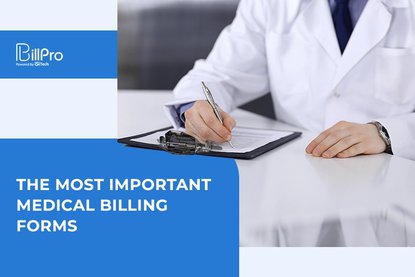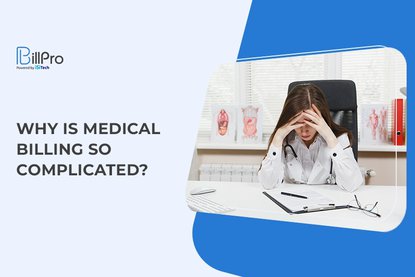Medical billing and coding are critical processes through which the reimbursement procedure for healthcare professionals is simplified. Though technically different, both are closely related in the process of submitting and following up on claims for healthcare services.
Medical billing and coding are crucial elements of the healthcare industry. They ensure that all healthcare providers receive compensation for the services and treatments provided to patients. They also enable patients to receive accurate and timely billing statements for their procedures.
Being a certified medical biller and coder can be quite a lucrative career, as they are always in high demand to maintain payment cycles within the industry.
Everything you need to know about starting a medical billing and coding career is covered below!
Are Medical Billing and Medical Coding Different?
Medical billing and coding involve converting clinical data and patient charts into medical claims submitted to insurance companies for payments. Though they are often performed by the same person or team, and the processes are closely related, they are not entirely the same.
What is Medical Coding?
Medical coding is, in some ways, a form of translation. A medical coding career requires an individual to convert a doctor’s diagnosis, prescription, and medical procedures or treatments into an alphanumeric or numeric code.
Each diagnosis, medical procedure, or injury has a corresponding code assigned based on certain classification systems:
-
International Classification of Diseases (ICD) - maintained by the Word Health Organization (WHO)
-
Current Procedure Terminology (CPT) - maintained by the American Medical Association (AMA)
These codes are periodically updated to accurately reflect current terminology and medical practices. They are considered a universal language that aids communication between insurance companies, insurance clearinghouses, government agencies, doctors, hospitals, and other healthcare-related organizations.
The coder reads the patient report submitted by the healthcare provider, then converts each piece of information into a code. There are specific codes for all elements indicated in these reports, such as the type of medical visit, the patient’s symptoms, all tests and procedures done, and the final diagnosis provided by the physician.
Medical coders must follow strict rules and guidelines. Accurate coding within these specifications is crucial as it will impact the claim once it is submitted. Certain codes must be placed in a particular order, such as those signifying a pre-existing condition.
Medical coding ensures that diagnoses and procedures are accurately described and recorded to facilitate a hassle-free billing process for patients, insurers, and healthcare providers.
What is Medical Billing?

Medical billing is the process through which information from the medical coder is used to create a bill or claim. It is the basis on which an insurance company will compensate a medical professional for the treatments or services they have provided to a patient.
After the coder translates the details of a patient’s medical procedure from start to finish, the medical biller can then create a claim. The claim includes all crucial information, including the symptoms, tests, diagnosis, and follow-ups from the first scheduled appointment to the last.
The claim is submitted to the patient’s insurance company for evaluation, after which it is returned to the biller. After the insurer has paid their share, the returned claim is evaluated to determine how much the patient needs to pay for their treatment.
If the patient is unwilling to pay their share of the bill, the medical biller is responsible for hiring a collections agency to ensure that the healthcare professional is compensated for their services.
Medical billing and coding software like BillPro is designed by experienced professionals to ensure accuracy and precision so all payments go through without a hitch. With the appropriate coding, clear and detailed descriptions of services and procedures, and accurate patient information provided by coders, the software ensures a smooth process.
How to Get Certified as a Medical Biller: What the Process Entails
If you’re looking to start a career in medical coding and billing, you may wonder how long it will take to be certified.
The answer is not so simple. The duration will vary depending on your previous experience in the medical field and the specific certification program you have chosen.
Depending on the program, you can complete your certification within a few weeks or months, perhaps longer.
Becoming a medical biller entails the following:
-
Researching and choosing a certification program that aligns with your career goals
-
Ensuring you meet the prerequisites for the program - having a highschool diploma or the equivalent of the same, or completing required training or coursework
-
Attending classes and completing exams, amongst other requirements to fulfill the certification program
-
Completing additional requirements which may involve a continuation of education or more practical experience
Being certified as a medical biller or coder may not be enough qualification to work in the field—it only kick-starts your medical biller or medical coder career path. You may also require a state license or certification and to pass a background check to work as a medical biller or coder. Passing the CPC exam may also be a necessity.
What is the CPC Exam?
The Certified Professional Coder (CPC) is an exam conducted by the American Academy of Professional Coders (AAPC). It covers a wide range of topics, including anatomy and physiology, medical terminology, and coding principles and practices for various medical specialties.
The CPC exam tests individuals on their knowledge of medical coding to ensure that their work is accurate and appropriate for medical claims.
To take the CPC exam, candidates must fulfill the eligibility criteria:
-
A high school diploma or its equivalent
-
Completed a coding program
-
Two years of experience as a medical coder if they have not completed a coding program
-
A clear background check
-
A signed agreement to adhere to the AAPC’s Code of Ethics
The CPC exam is administered at testing centers all over the country, via computers.
Candidates are given five hours to answer 150 multiple-choice questions and must achieve a minimum score of 70% to pass.
Once they pass the exam, candidates are certified as CPC medical coders. They can use their CPC credentials to prove their medical coding ability to potential employers.
How to Study and Prepare to Become a Medical Biller

If you wish to become a medical biller, it will require some hard work and effort on your part. Here are a few tips to help you:
-
Familiarize yourself with the responsibilities and duties of a medical biller so you can understand the expectations you must meet.
-
Enroll in a medical billing course or certification program to gain the knowledge and skills required to become a medical biller.
-
Gain practical experience through an internship or shadowing. The hands-on experience will give you valuable insights into the job.
-
Seek out additional resources, such as study groups, online tutorials, or forums that will supplement your studies.
Final Thoughts
Medical billing and coding require precision and accuracy, as even minor errors can have grievous repercussions in the payment process. This is why multiple steps are involved in building a medical billing and coding career—intensive study, certifications, exams, first-hand experience, and more.
Supplementing highly trained coders with robust medical billing and coding software will take your business to the next level. Contact us for a demo today and get 90 day trial!

 3.7/5 (3 votes)
3.7/5 (3 votes)
 202 views
202 views



